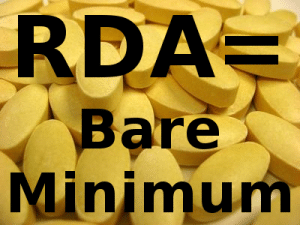RDAs (Recommended Dietary Allowances) are guidelines created by the Food and Nutrition Board of the National Academy of Sciences’ Institute of Medicine. Their purpose was to tell the public how much of each individual vitamin and mineral your body needs.
It Sounds like a great idea…so what’s the problem with the RDA?
 The commonly held belief is that if we meet the RDAs, our nutritional needs will be amply covered…right? The problem with this premise is that research over the last decade or two shows that the RDAs are set far too low for most vitamins and supplements. A much better way to look at the RDAs is as a MINIMUM recommended amount. The RDAs are certainly not at OPTIMAL levels, which is where you ideally want to be.
The commonly held belief is that if we meet the RDAs, our nutritional needs will be amply covered…right? The problem with this premise is that research over the last decade or two shows that the RDAs are set far too low for most vitamins and supplements. A much better way to look at the RDAs is as a MINIMUM recommended amount. The RDAs are certainly not at OPTIMAL levels, which is where you ideally want to be.
A great example of this at work is Vitamin C. The RDA for vitamin C is only 60 mg, which is the minimum amount to keep us from getting scurvy. However, for optimal heart health and immune function you should take at least 1,000 mg daily.
Isn’t it unsafe to take too much?
For some vitamins and minerals there are upper safe limits that you should not go over, but that level is often so many times the RDA. For example, the RDA for vitamin B12 is only 1 mcg and an upper safe limit is at least 500 times that amount!
So how do I know how much to take?
Some vitamins and minerals have optimal range guidelines that will work for most people. For example, a good optimal level for vitamin C can be calculated based on a persons weight by taking 1,000mg per 25 lbs of body weight. Make sure you spread this out over the course of a day though so you don’t get lose stools.
However, to obtain optimal levels for some supplements requires getting a lab test to make sure you are not taking too much. For example, an optimal Vitamin D3 level is a critical component for overall health. I recommend this test to all my patients have have found that 80-90% of people I test are deficient. Have your practitioner test you for 25 Hydroxy D and try and have your level between 60 -80. Most lab tests consider over 30 “normal” but this is not “optimal”. The objective is always to find the dose for you that will put you in the optimal range.
Vitamin Deficiency Testing
The best approach to optimizing your vitamin and nutrient supplementation is by getting nutritional & vitamin deficiency testing done. This is a quick test that is performed by taking a blood sample which then goes through a detailed evaluation to look at the levels of 33 different vitamins, minerals, and antioxidants. You then need to have the results analyzed by your practitioner. It is important to work with a qualified physician / expert who understands how to optimize your nutrients and help you with your individual needs.
I hope you found this information helpful. Please feel free to ask any questions or leave any comments below. If you require any assistance with nutritional & vitamin deficiency testing you can request a consultation today!


















